I suspected that at some point in the summer of 2020, I would visit an island off the southwest coast of Korea. While looking at the map on my kitchen wall, I picked Jido along with a nearby town on the mainland called Muan. Neither had especially strong credentials for a history-minded traveler, but I knew good things were bound to happen.
It was necessary to first travel south to Gwangju and then buy another ticket to Muan 38 kilometers to the west. Upon arrival, I was quite pleased 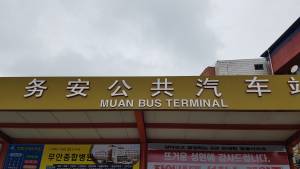 because the bus terminal was right in the middle of town, there was a plethora of hotels, and a tourist office with maps and brochures stood across the street.
because the bus terminal was right in the middle of town, there was a plethora of hotels, and a tourist office with maps and brochures stood across the street.
Almost immediately, I found a historical nugget although one of recent vintage. Just in front of the bus terminal was a marker about the Gwangju Democratization Struggle, also known as the May 18 (1980) Democratic Uprising. This 10-day resistance to the martial-law policy of Chun Doo-hwan was some serious stuff—the people daring to grab guns and fight the army and police. They had good reason to be incensed, as soldiers were shooting at them from helicopters. Even today, this is a point of political contention among Koreans. About 2,000 people died, although the government’s number was much smaller. News of the bloody crackdown spread in all directions, including to Muan. Locals, the marker stated, fully supported the protesters and gave them sustenance. Within a few hours, I would see a banner that was still up seven weeks after a commemoration ceremony of some kind.
Also close by was a Buddhist temple, but one whose name I could not discern despite a historical plaque out front. Its most distinguishing feature was a 3-meter-high stone Buddha who was said to save people 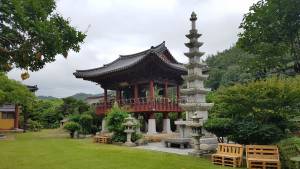 from suffering and disaster. Wearing an usnisa topknot, his left hand held a bottle of medicine, while his right stretched forward with the palm facing up.
from suffering and disaster. Wearing an usnisa topknot, his left hand held a bottle of medicine, while his right stretched forward with the palm facing up.
Aided by relatively cool mid-summer weather, I walked and walked. I passed by a group of older women wearing bonnets who carefully tended a field; Chodang University (established in 1994); the Muan governmental office; the Muan Korean Classical Music Institute; a number of burial mounds from centuries gone by; and a monument dedicated to Choi Ik-hyeon (pen name “Myeonnam”), a late Joseon dynasty scholar, politician, philosopher and fighter against the colonizing Japanese.
The bus terminal and my hotel were located next to Muan’s Nakji Street. Nakji means baby octopus, distinct from the giant octopus. The former can be found near the shore and the latter in the deeper 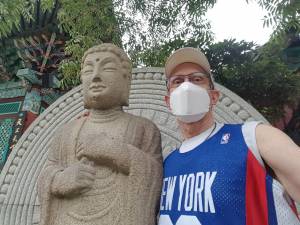 regions of the sea. Nakji Street was lined with about 20 restaurants devoted to this delicacy. I went into one and ordered nakji bibimbap.
regions of the sea. Nakji Street was lined with about 20 restaurants devoted to this delicacy. I went into one and ordered nakji bibimbap.
I called my friend Choi Ha-sook in Gimhae and sought her help. She told the lady at the bus terminal that I wanted to buy a ticket to Jido, leaving mid-morning of the next day. Although she complied, she appeared to do so reluctantly. Ha-sook and I agreed that this woman was in dire need of an attitude adjustment. I went out of my way to thank her and give her a smile, but she just scowled.
A few things deserve to be mentioned before saying goodbye to Muan. A white lotus festival is held annually, Muan International Airport is now the sky hub of Korea’s Honam region, and it has a pumba training center. Who knew that pumba, the music of the lowliest vagabonds, could be taught in an academic setting?
The next morning, I had an hour to kill before the bus left. I went to a nearby Paris Baguette, drank a café  latte, finished reading a biography of Howard Cosell and started a book about the Salem witchcraft trials of 1692. Curiously, this shop’s Christmas tree was still standing. It brought back memories of Brave Combo’s song, “Christmas in July.”
latte, finished reading a biography of Howard Cosell and started a book about the Salem witchcraft trials of 1692. Curiously, this shop’s Christmas tree was still standing. It brought back memories of Brave Combo’s song, “Christmas in July.”
Traveling in a northwesterly direction, we passed through Palbangmin village and a peninsula called Haeje, crossed a bridge and were on Jido. I really did not know what might be in store, but there was nothing to worry about. I started perambulating. As I approached a church—Korean churches are known for steeples stretching up to the sky—I could hear the choir and congregation singing a hymn. Short pants and a bright Julius Erving New York Nets jersey did not constitute proper church attire, so I was somewhat hesitant to enter. I did, however, and sat on the back row. The service was almost over, and when the faithful filed out most of them looked at me as the strangest of strangers.
Pastor Peter Kim, however, was unbothered. He greeted me and said he would be back after a short business meeting. In the meantime, I talked with his 14-year-old daughter Lily. She informed me that she is the church’s piano player, the subject of her father’s sermon had been “believe  in miracles,” she likes K-pop, and she plans to become a teacher someday. I signed a copy of A Seoul Miscellany and gave it to Lily, along with a Jikji T-shirt for her friend Jenny.
in miracles,” she likes K-pop, and she plans to become a teacher someday. I signed a copy of A Seoul Miscellany and gave it to Lily, along with a Jikji T-shirt for her friend Jenny.
Peter, this kind man of the cloth, came and walked me a kilometer or so to a pension owned by his friend. It cost 50,000 won but was bigger and fancier than my usual lodgings on the road. We shook hands, and I was on my own. I had hoped that I might be able to find a beach and do some rudimentary swimming. That did not happen, although I saw plenty of water and savored the fresh air and relative absence of cars.
I noticed Jimyung High School, where Lily will soon presumably attend. There was also a poster for Kang Hye-won, although I am not sure whether she had any connection to Jido. This woman, who was born in 1885 and died 97 years later, was a vigorous supporter of Korean independence during the Japanese 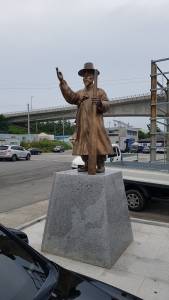 colonial era. She did her work, however, in the USA. In 2016, Kang’s remains were disinterred and brought back home. Her final resting place is Daejeon National Cemetery.
colonial era. She did her work, however, in the USA. In 2016, Kang’s remains were disinterred and brought back home. Her final resting place is Daejeon National Cemetery.
The following morning, I took a 30-minute walk in the opposite direction. It was extended because of two interruptions. First was an auction of large batches of fish; exactly who was selling and who was buying, I cannot say. I walked among these hardy men and admired them, but I would not have wanted to do their work. Second was a statue of Moon Sun-deok (1777−1847). A local fisherman, he and five 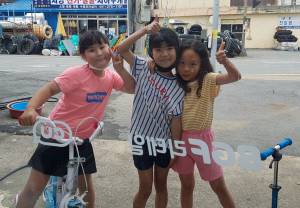 others were hit by a typhoon in 1801. They landed at Okinawa and began making their way home on a China-bound ship. It sank, however, and they washed up on the shores of a Philippine island. Moon et al. also sojourned at Macao before getting to sweet home Korea in 1805. Their friends and family members must have been treated to some fabulous stories.
others were hit by a typhoon in 1801. They landed at Okinawa and began making their way home on a China-bound ship. It sank, however, and they washed up on the shores of a Philippine island. Moon et al. also sojourned at Macao before getting to sweet home Korea in 1805. Their friends and family members must have been treated to some fabulous stories.
Rather to my surprise, a bus would go all the way from Jido to Seoul. Waiting for departure, I had a most pleasant encounter with three island girls. I was actually in a convenience store adjacent to the terminal, drinking caramel coffee and reading. I looked out the window and saw them pull up on their bikes and scooters. This trio, about eight years old, had no fear of the foreigner. They grinned broadly, made goofy faces, posed for photos and waved. So cute!

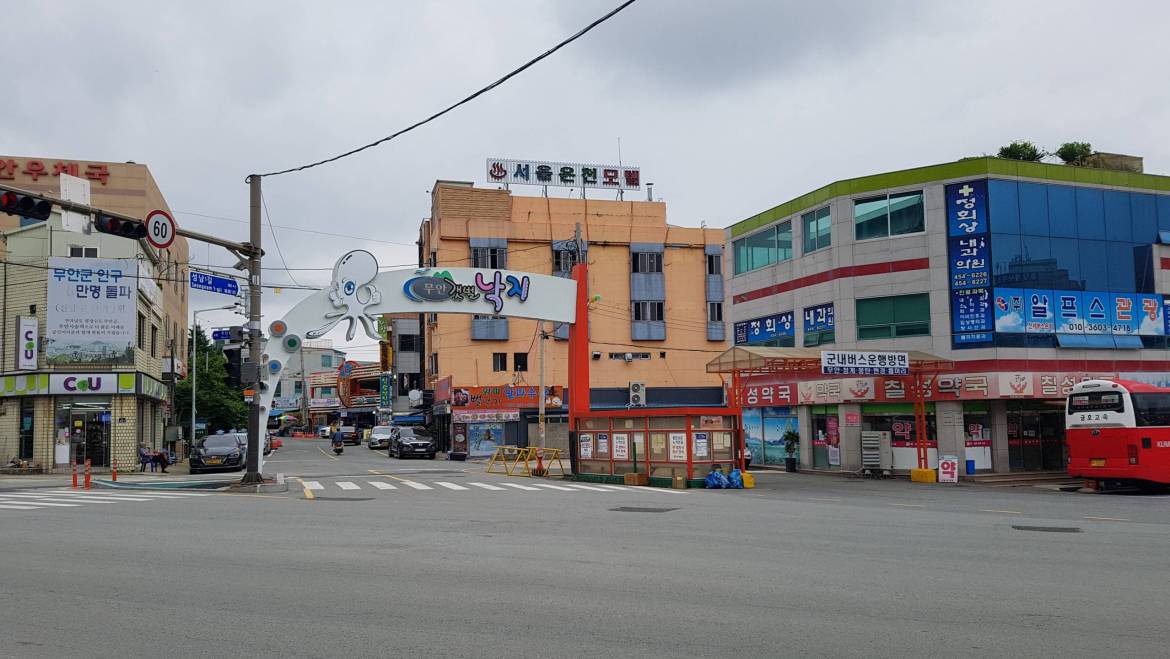
7 Comments
A Buddha can never save people, the only one who does it, is God.
Very interesting your article about the trip to the island and more interesting to see a winter tree still adorned in the middle of summer. Wish you all the best !
Elly, I know that. I am no Buddhist. Both Muan and Jido were beautiful and a nice change from the crowded big city of Seoul.
I enjoyed your story!! You put Rick Steve’s to shame! I know that the sea fishermen are a truly hardy bunch. I have heard many tales of the Irish fishermen – many never to return home after sailing out to sea.
Thank you, Sharon. But who is Rick Steve??
He’s the PBS travel guy who’s done travel shows all over the world.
Hi Richard- enjoyed your story. I could picture it all as you were walking along describing the area. so glad you are able to connect with the “real “people you encounter not just the tourist version .Be glad you are in Korea today the weather is over 100
Kamsahamnida…that’s “thank you” in Korean!
Add Comment